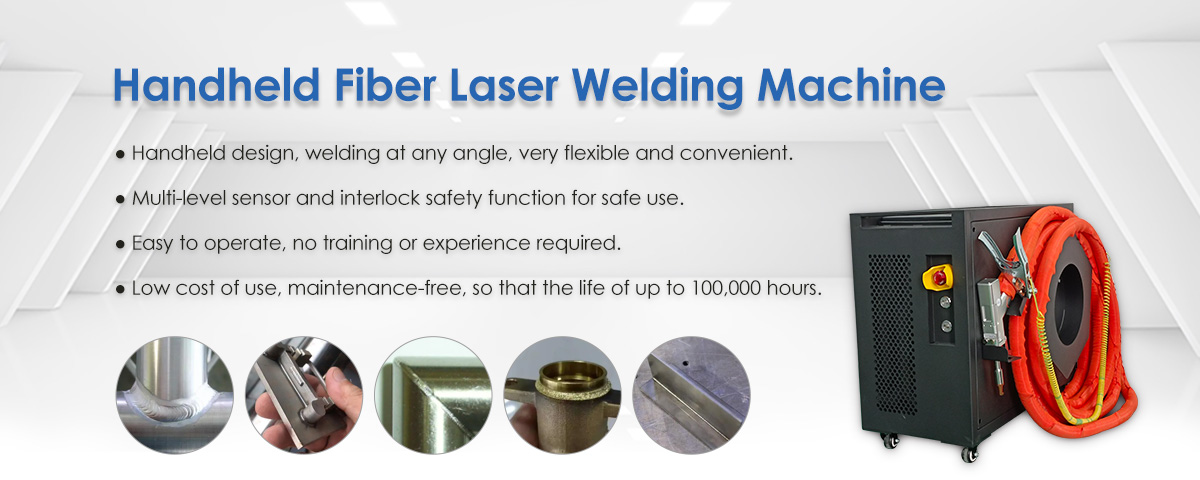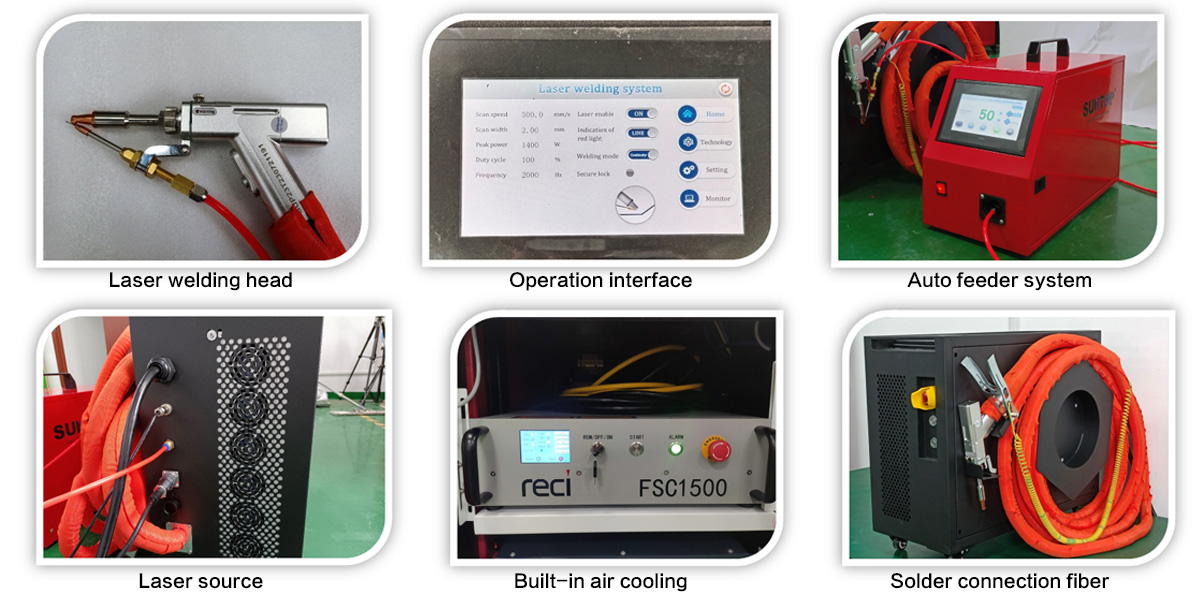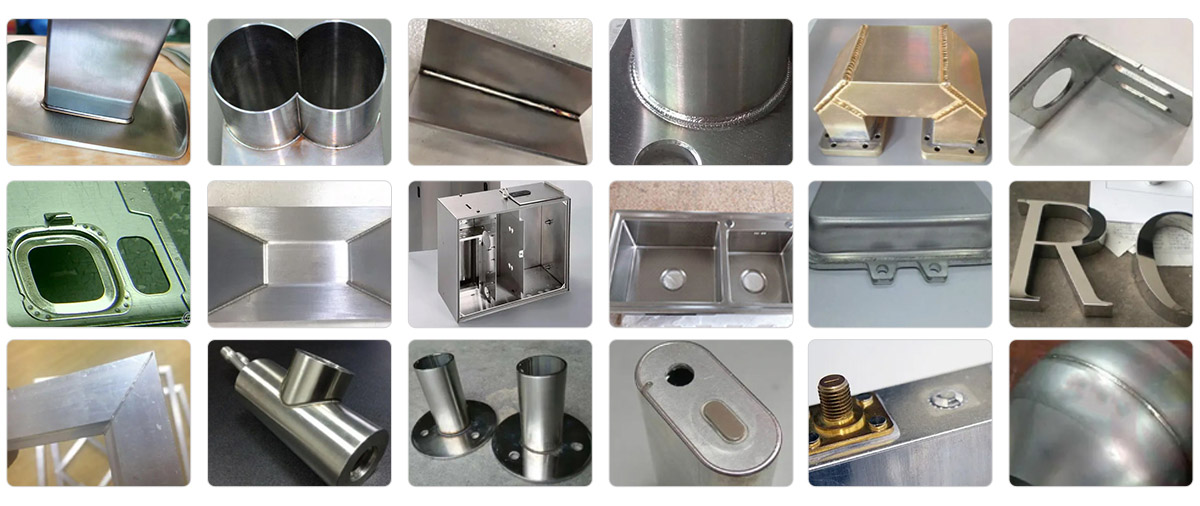
Laser welding technology is a modern and advanced welding method that uses high-energy laser beams to quickly melt and join metal materials, achieving efficient and high-precision welding. As one of the applications of laser technology, laser welding machines have a wide range of applications and significant value.
The components of a laser welding machine.
A laser welding machine is a device that uses a powerful laser beam for welding processes, with core components including:
1.Laser source: The laser source is one of the core components of a laser welding machine, mainly used to generate high-energy density laser beams. Common laser sources include CO2 lasers, fiber lasers, etc., each with different characteristics and applications.
2. Optical system: The optical system is used to guide, focus, and control the transmission direction and focal length of the laser beam, typically including lenses, mirrors, focal length adjusters, etc. A high-quality optical system ensures the stability and precision of the laser beam.
3. Worktable: The worktable is the working platform of the laser welding machine, used to place and clamp the workpieces to be welded. The worktable usually has a multi-axis motion control system for precise positioning and movement of the workpieces.
4. Control system: The control system is the intelligent core of the laser welding machine, including hardware and software components. The control system can monitor and adjust laser parameters, optical systems, worktable movements in real-time, ensuring the accuracy and stability of the welding process.
5. Gas protection system: During the laser welding process, inert gases (such as argon) or reactive gases (such as oxygen) are typically used to protect the welding area, preventing oxygen or other impurities from affecting the welding quality.
6. Cooling system: Laser welding machines generate a large amount of heat during operation, requiring a cooling system to effectively dissipate heat from the laser source, optical system, and other components, ensuring long-term stable operation of the equipment.
These are the main core components of a laser welding machine, which work closely together to complete the laser welding process, achieving efficient and precise welding operations. High-quality laser welding machines, based on these core components, can achieve more efficient and precise welding results through precise design and intelligent control, meeting various welding requirements. Learn more laser welding machine.
Common types of laser welding machines

Laser welding machines can be classified based on the type of laser used, power level, operating mode, among other methods. Based on the type of laser, they can be categorized as:
1. CO2 laser welding machine
2. Fiber laser welding machine
3. Semiconductor laser welding machine
4. Nd:YAG laser welding machine
Based on power level, they can be categorized as:
1. Low-power laser welding machine
2. Medium-power laser welding machine
3. High-power laser welding machine
Based on operating mode, they can be categorized as:
1. Handheld laser welding machine
2. Desktop laser welding machine
3. Automated laser welding machine
Additionally, they can be customized based on the specific characteristics and requirements of the welding objects.
The application of laser welding machines
Laser welding machines have significant application value in traditional manufacturing industries, providing key technical support for sectors such as automotive manufacturing, aerospace, electronics, medical equipment manufacturing, among others:
1. Automotive manufacturing: Laser welding machines are widely used in the automotive manufacturing industry for welding automotive components, body structures, exhaust pipes, and other critical parts. Laser welding technology enables high-speed, high-quality welding, improving production efficiency and product quality.
2. Electronics industry: In the electronics industry, laser welding machines are commonly used for welding miniature electronic components, circuit boards, connectors, and other parts. Their high energy density and precise control capabilities ensure accurate welding positions and small heat-affected zones, suitable for fine welding of electronic devices.
3. Aircraft aerospace industry: Laser welding machines are widely used in the aerospace sector for welding aircraft engine components, spacecraft structural parts, among others. Laser welding technology enables high-strength, high-quality welding, enhancing product reliability and safety.
4. Metal processing industry: Laser welding machines are widely used in the metal processing industry, including metal products, furniture, pipes, tools, among other areas. Laser welding can achieve high-speed, efficient welding without the need for additional welding materials, reducing production costs.
5. Medical equipment manufacturing industry: Laser welding technology is extensively used in the medical equipment manufacturing sector for welding medical instruments, medical devices, among others. High precision laser welding technology plays a crucial role in welding medical devices that require no damage or bacterial contamination.
In conclusion, laser welding machines have important applications in various industries, providing efficient, precise, and clean welding solutions, driving the development and progress of industrial production.
In addition to traditional manufacturing industries, laser welding machines also demonstrate significant potential in emerging fields. In 3D printing technology, laser welding machines are used in the printing process of metal parts, achieving customized production and rapid manufacturing goals. In the context of intelligent manufacturing and Industry 4.0, the automation and intelligence development of laser welding machines are unstoppable, becoming a crucial driving force for industrial upgrading and innovation.

The advantages laser welding machines
Compared to traditional welding methods, laser welding machines have numerous advantages.
Laser welding machines have the following ten major advantages compared to traditional welding machines:
1. High precision: Laser welding machines can achieve high-precision welding, capable of welding tiny precision components.
2. High efficiency: Laser welding machines have fast welding speeds, improving production efficiency.
3. Clean and environmentally friendly: Laser welding processes do not require contact with the workpiece surface, reducing waste production and achieving clean and environmentally friendly operations.
4. Small heat-affected zone: Laser welding machines have low heat input, resulting in a small heat-affected zone, reducing the risk of deformation and cracks.
5. Strong controllability: Laser welding machines can precisely control welding parameters through software, adapting to different welding requirements.
6. Automation: Laser welding machines can be integrated with automated production lines, achieving automated welding and improving production efficiency.
7. Non-contact: Laser welding is a non-contact welding process, avoiding damage to the workpiece surface.
8. No need for additional welding materials: Laser welding does not require additional welding materials, saving production costs.
9. Energy-saving: Laser welding processes have low energy consumption, saving energy consumption.
10. Applicable to various materials: Laser welding can be used for welding various metals and non-metal materials, with wide applicability.
The influenced price factors of laser welding machines
The price of laser welding machines is influenced by various factors, with the following 12 main factors:
1. Laser power: The laser power of a laser welding machine determines its welding capability, with higher laser power usually resulting in a relatively higher price.
2. Welding speed: Higher welding speeds typically require more advanced technology and equipment, thus affecting the price of laser welding machines.
3. Work area size: Laser welding machines with large work areas usually have higher prices, as they require larger-sized equipment and more powerful laser sources.
4. Type of laser source: Different types of laser sources have different prices and performance, such as CO2 lasers, fiber lasers, choosing different laser sources can affect the price of laser welding machines.
5. Degree of automation: Laser welding machines with high levels of automation usually have higher prices, as they require more automation control systems and devices.
6. Manufacturing process and quality: High-quality manufacturing processes and materials will increase the price of laser welding machines.
7. Control system: Advanced control systems and software can increase the cost of laser welding machines but also improve operational convenience and efficiency.
8. Brand reputation: Laser welding machines from well-known brands usually have higher prices due to brand reputation and after-sales service guarantees.
9. Equipment stability and reliability: Laser welding machines with higher stability and reliability usually have higher prices, as they use more advanced technology and design.
10. Additional functions and accessories: Advanced functions and accessories such as rotary tables, automatic loading systems, can increase the price of laser welding machines.
11. Regional factors: Market demand, labor costs, tax rates, and other factors in different regions can also affect the price of laser welding machines.
12. Technological prospects and competition: Market demand for new technologies and product competition can directly impact the price changes of laser welding machines.
Laser welding technology, as a high-precision and efficient welding method, has broad application prospects.
Suntop Laser is a Chinese manufacturer of laser welding machines with over 20 years of export experience. Our customers are spread across more than 200 countries and regions worldwide, and we have received high praise from them. Please feel free to contact us for a quote.
The future trends of laser welding
The future trends of laser welding technology mainly include the following aspects:
1. High power: Future laser welding technology will develop towards high power, increasing laser power will help improve welding speed and depth, adapting to a wider range of application needs.
2. Intelligence: With the development of artificial intelligence and automation technology, future laser welding equipment will become more intelligent, achieving automated control, intelligent optimization parameter adjustments, and other functions, improving production efficiency and product quality.
3. Multifunctionality: Future laser welding technology will combine multiple functions, such as laser cutting, laser marking, etc., integrating multiple processes to enhance equipment multifunctionality and comprehensive utilization value.
4. High precision: Laser welding technology has made significant achievements in welding precision, and in the future, it will further improve welding precision to meet the demands of more refined and complex structure welding requirements.
5. Nanoscale welding: Future laser welding technology is expected to achieve nanoscale welding precision, applied in microdevices, microelectronic devices, and other fields, promoting the development of micro-nano processing technology.
6. Green and environmentally friendly: Future laser welding technology will pay more attention to environmental requirements, reducing waste production, saving energy consumption, achieving clean production, in line with the trend of environmental protection.
7. Material adaptability: Future laser welding technology will continue to expand the range of applicable materials, including metals, non-metals, composite materials, etc., meeting various material welding requirements.


























